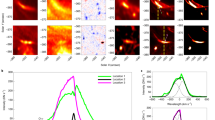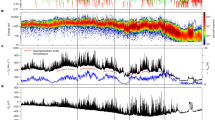Abstract
Broad regions on both sides of the solar wind termination shock are populated by high intensities of non-thermal ions and electrons. The pre-shock particles in the solar wind have been measured by the spacecraft Voyager 1 (refs 1–5) and Voyager 2 (refs 3, 6). The post-shock particles in the heliosheath have also been measured by Voyager 1 (refs 3–5). It was not clear, however, what effect these particles might have on the physics of the shock transition until Voyager 2 crossed the shock on 31 August–1 September 2007 (refs 7–9). Unlike Voyager 1, Voyager 2 is making plasma measurements7. Data from the plasma7 and magnetic field8 instruments on Voyager 2 indicate that non-thermal ion distributions probably have key roles in mediating dynamical processes at the termination shock and in the heliosheath. Here we report that intensities of low-energy ions measured by Voyager 2 produce non-thermal partial ion pressures in the heliosheath that are comparable to (or exceed) both the thermal plasma pressures and the scalar magnetic field pressures. We conclude that these ions are the >0.028 MeV portion of the non-thermal ion distribution that determines the termination shock structure8 and the acceleration of which extracts a large fraction of bulk-flow kinetic energy from the incident solar wind7.
This is a preview of subscription content, access via your institution
Access options
Subscribe to this journal
Receive 51 print issues and online access
$199.00 per year
only $3.90 per issue
Buy this article
- Purchase on Springer Link
- Instant access to full article PDF
Prices may be subject to local taxes which are calculated during checkout


Similar content being viewed by others
References
Krimigis, S. M. et al. Voyager 1 exited the solar wind at a distance of ∼85 au from the Sun. Nature 426, 45–48 (2003)
McDonald, F. B. et al. Enhancements of energetic particles near the heliospheric termination shock. Nature 426, 48–51 (2003)
Stone, E. C. et al. Voyager 1 explores the termination shock region and the heliosheath beyond. Science 309, 2012–2020 (2005)
Decker, R. B. et al. Voyager 1 in the foreshock, termination shock, and heliosheath. Science 309, 2020–2024 (2005)
Krimigis, S. M. et al. in Connecting Sun and Heliosphere (Proc. Solar Wind 11/SOHO 16 Conf.) (eds Fleck, B., Zurbuchen, T. H. & Lacoste, H.) 21–28 (ESA, Noordwijk, 2005)
Decker, R. B. et al. in Physics of the Inner Heliosheath: Voyager Observations, Theory, and Future Prospects (Proc. 5th IGPP Internat. Astrophys. Conf.) (eds Heerikhuisen, J., Florinski, V., Zank, G. P. & Pogorelov, N. V.) 73–78 (AIP, Melville, New York, 2006)
Richardson, J. D. et al. Cool heliosheath plasma and deceleration of the upstream solar wind at the termination shock. Nature 10.1038/nature07024 (this issue)
Burlaga, L. F. et al. Magnetic fields at the solar wind termination shock. Nature 10.1038/nature07029 (this issue)
Gurnett, D. A. & Kurth, W. S. Intense plasma waves at and near the solar wind termination shock. Nature 10.1038/nature07023 (this issue)
Krimigis, S. M. et al. The Low Energy Charged Particle (LECP) experiment on the Voyager spacecraft. Space Sci. Rev. 21, 329–354 (1977)
Richardson, J. D. et al. Source and consequences of a large shock near 79 AU. Geophys. Res. Lett. 33, L23107 (2006)
Opher, M., Stone, E. C. & Liewer, P. C. The effects of a local interstellar magnetic field on Voyager 1 and 2 observations. Astrophys. J. 640, L71–L74 (2006)
Pogorelov, N. V. in Physics of the Inner Heliosheath: Voyager Observations, Theory, and Future Prospects (Proc. 5th IGPP Internat. Astrophys. Conf.) (eds Heerikhuisen, J., Florinski, V., Zank, G. P. & Pogorelov, N. V.) 3–13 (AIP, Melville, New York, 2006)
Pogorelov, N. V., Stone, E. C., Florinski, V. & Zank, G. P. Termination shock asymmetries as seen by the Voyager spacecraft: The role of the interstellar magnetic field and neutral hydrogen. Astrophys. J. 668, 611–624 (2007)
Jokipii, J. R., Giacalone, J. & Decker, R. B. Energy spectra of energetic particles upstream of the termination shock. Eos 88 (Fall meeting), abstr. SH11A–07 (2007)
Washimi, H. et al. A forecast of the heliospheric termination-shock position by three-dimensional MHD simulations. Astrophys. J. 670, L139–L142 (2007)
le Roux, J. A., Webb, G. M., Florinski, V. & Zank, G. P. A focused transport approach to pickup ion shock acceleration: Implications for the termination shock. Astrophys. J. 662, 350–371 (2007)
Giacalone, J. & Jokipii, J. R. Energetic particles around the termination shock: Numerical simulations for a blunt shock with cross-field diffusion. Astrophys. J. 649, L137–L140 (2006)
Fisk, L. A., Gloeckler, G. & Zurbuchen, T. H. Acceleration of low-energy ions at the termination shock of the solar wind. Astrophys. J. 644, 631–637 (2006)
Burlaga, L. F. et al. Crossing the termination shock into the heliosheath: magnetic fields. Science 309, 2027–2029 (2005)
Gurnett, D. A. & Kurth, W. S. Electron plasma oscillations upstream of the solar wind termination shock. Science 309, 2025–2027 (2005)
Richardson, J. D. et al. Relation between the solar wind dynamic pressure at Voyager 2 and the energetic particle events at Voyager 1. J. Geophys. Res. 110, A09106 (2005)
Acknowledgements
Work at the Johns Hopkins University Applied Physics Laboratory was supported by the Voyager Interstellar Mission under NASA grant NNX07AB02G.
Author information
Authors and Affiliations
Corresponding author
PowerPoint slides
Rights and permissions
About this article
Cite this article
Decker, R., Krimigis, S., Roelof, E. et al. Mediation of the solar wind termination shock by non-thermal ions. Nature 454, 67–70 (2008). https://doi.org/10.1038/nature07030
Received:
Accepted:
Issue Date:
DOI: https://doi.org/10.1038/nature07030
This article is cited by
-
Future Exploration of the Outer Heliosphere and Very Local Interstellar Medium by Interstellar Probe
Space Science Reviews (2023)
-
Recent Developments in Particle Acceleration at Shocks: Theory and Observations
Space Science Reviews (2022)
-
Observations of the Outer Heliosphere, Heliosheath, and Interstellar Medium
Space Science Reviews (2022)
-
The Structure of the Large-Scale Heliosphere as Seen by Current Models
Space Science Reviews (2022)
-
The Structure of the Global Heliosphere as Seen by In-Situ Ions from the Voyagers and Remotely Sensed ENAs from Cassini
Space Science Reviews (2022)
Comments
By submitting a comment you agree to abide by our Terms and Community Guidelines. If you find something abusive or that does not comply with our terms or guidelines please flag it as inappropriate.



